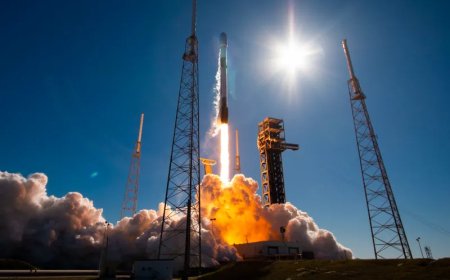Starship Launches May Delay Florida Flights by 2 Hours

SpaceX's ambitious plans to launch its next-generation rocket, Starship, from Florida are poised to significantly impact the state's rapidly evolving aviation landscape. As the company gears up for its high-profile missions, the implications for Florida's airports and the broader aerospace ecosystem are both extensive and intriguing.
For those unfamiliar, Starship is designed to be a fully reusable spacecraft that can carry humans and cargo to destinations such as the Moon, Mars, and beyond. SpaceX aims to revolutionize space travel, making it more accessible and cost-effective. With the company's headquarters in Hawthorne, California, the move to launch Starship from Florida is indicative of a strategic shift that could reshape the state’s aviation dynamics.
Historically, Florida has been a cornerstone of America’s space endeavors, with Cape Canaveral and Kennedy Space Center serving as launch pads for countless missions. The state’s geographical advantages, including its proximity to the equator and expansive ocean areas for safe rocket landings, make it an ideal location for space launches. However, as SpaceX increases its launch cadence, the potential repercussions for Florida's commercial airports cannot be overlooked.
Florida's airports, particularly those in close proximity to Cape Canaveral, such as Orlando International Airport (MCO) and Melbourne International Airport (MLB), may see a surge in activity. These airports already play a pivotal role in accommodating tourists visiting the Space Coast, but SpaceX's operations could amplify air traffic significantly. With each launch, there is a potential increase in demand for air travel, as enthusiasts, journalists, and industry professionals flock to witness these groundbreaking events.
Moreover, the economic ripple effects of SpaceX's operations could be substantial. According to a report from the Space Foundation, the space economy is projected to reach $1 trillion by 2040. Florida's airports stand to benefit from this burgeoning sector, which could lead to enhanced flight routes, increased passenger volumes, and expanded services tailored to the aerospace industry. Airlines may find new opportunities to establish direct connections to major cities hosting aerospace events, thus catering to a growing demographic of space enthusiasts and professionals.
The increased traffic and interest in the region may also spur further investments in airport infrastructure. As airports anticipate higher passenger volumes, upgrades to terminals, runways, and other facilities will become necessary. The Federal Aviation Administration (FAA) has been known to support such initiatives, especially when they align with national interests in promoting aerospace advancements. Enhanced airport facilities could result in improved passenger experiences while simultaneously accommodating the unique needs of the space industry.
However, with opportunity comes challenge. The coordination between SpaceX's launch schedule and commercial flight operations will require meticulous planning. Launch windows often necessitate airspace restrictions, which could lead to temporary flight delays or cancellations in the vicinity of launch sites. Airports, airlines, and SpaceX must work collaboratively to ensure that launch activities do not severely disrupt commercial aviation. Ongoing dialogue and partnership will be crucial to maintain a harmonious balance between space exploration and air travel.
Additionally, safety concerns cannot be understated. Launch operations inherently carry risks, and ensuring the safety of both air and space traffic is paramount. The FAA and other regulatory bodies will need to continuously evaluate and adapt their safety protocols as SpaceX ramps up its launch schedule. Providing real-time information and updates to air traffic controllers and pilots will be essential to mitigate potential hazards stemming from rocket launches.
On a broader scale, SpaceX's presence in Florida may catalyze a renewed interest in STEM (science, technology, engineering, and mathematics) education and careers within the state. The aerospace industry often requires a skilled workforce, and as more companies look to establish operations in Florida, local educational institutions may respond by expanding their programs in aerospace engineering and related fields. This could lead to a new generation of professionals eager to participate in the evolving space economy.
Furthermore, Florida's reputation as a space launch hub will likely receive a significant boost. While historic launches have long captured international attention, the regularity of SpaceX's Starship missions could elevate the state's profile on the global stage. A thriving space industry can attract additional players, from startups to established aerospace giants, looking to capitalize on Florida's favorable conditions. This influx of companies may lead to robust job creation and economic growth, solidifying Florida's status as a leader in the aerospace sector.
In conclusion, SpaceX's plans to launch Starship from Florida promise to usher in a new era for the state’s airports and its overall aviation ecosystem. The interplay between commercial air travel and space exploration will require innovative solutions and collaborative efforts amongst stakeholders. With the potential for increased air traffic, economic growth, and a heightened focus on aerospace education, Florida stands on the brink of a transformative period. As SpaceX continues to pioneer the future of space travel, the implications for Florida's aviation landscape will be closely watched by industry experts and enthusiasts alike.
The journey ahead is filled with challenges and opportunities, but one thing is certain: Florida's role in the aerospace industry is set to expand significantly, and the eyes of the world will be fixed on its skies.
What's Your Reaction?
 Like
0
Like
0
 Dislike
0
Dislike
0
 Love
0
Love
0
 Funny
0
Funny
0
 Angry
0
Angry
0
 Sad
0
Sad
0
 Wow
0
Wow
0































